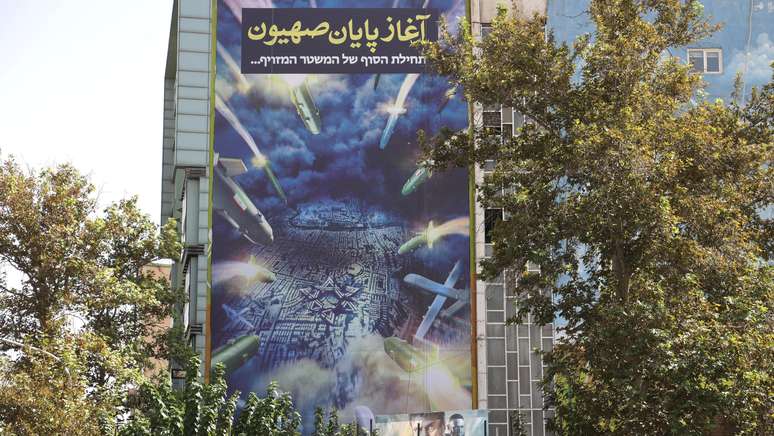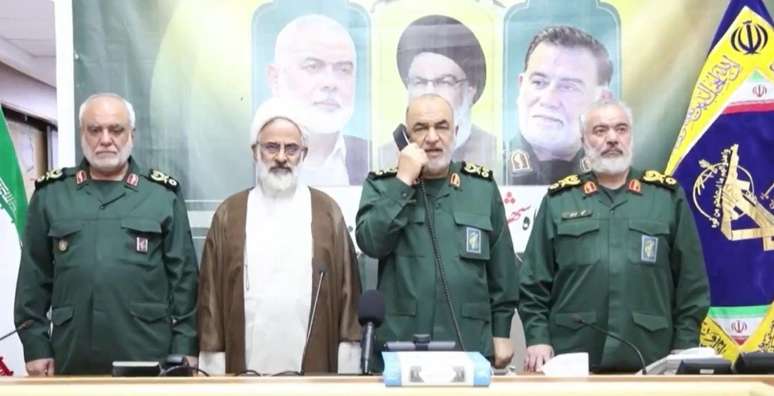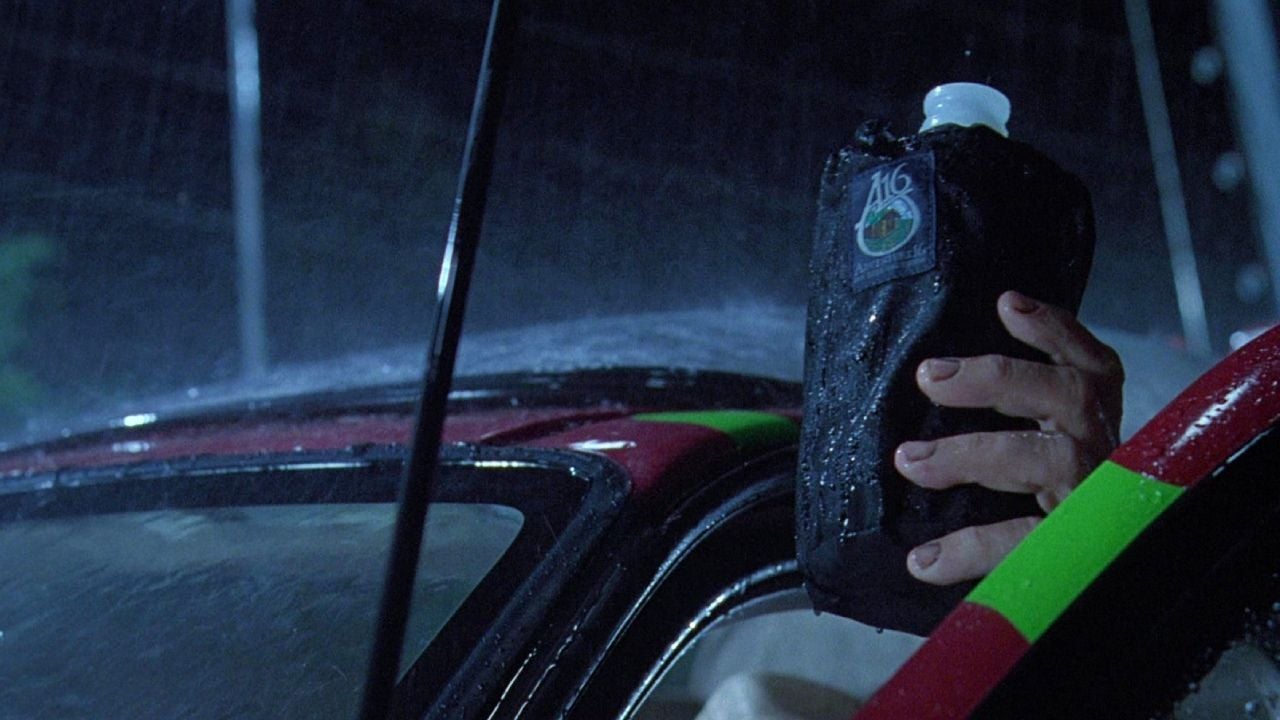Iranian leaders are preparing for Israeli retaliation after the launch of around 200 ballistic missiles.
On Tuesday, Maj. Gen. Hossein Salami, commander-in-chief of the Islamic Revolutionary Guard Corps (IRGC), stood in front of a large poster in a war room as he used a telephone to order the launch of about 200 ballistic missiles against Israel night (1/10), according to a video published by Iranian media.
The poster featured photos of three men whose deaths Iran sought to avenge with the attack: Hamas political leader Ismail Haniyeh, killed in Tehran in July in an attack that Iran blamed on Israel; Hezbollah leader Hassan Nasrallah; and the operations commander of the IRGC Quds Force, Brigadier General Abbas Nilforoushan.
Nasrallah and Nilforoushan were killed last week in an Israeli airstrike in Beirut.
The IRGC said the hypersonic missiles took 12 minutes to reach Israel and successfully hit targets including three Israeli air bases and the headquarters of the Mossad spy agency.
However, the Israel Defense Forces (IDF) said that most of the missiles were “intercepted by Israel and a US-led defense coalition” and that there were a “small number of hits” in the center and in southern Israel.
Shortly after the attack, a large banner was erected in Tehran’s Palestine Square, with missiles flying towards buildings in the shape of the Star of David and the words “The beginning of the end of Zionism”.

Iran appears to have shown restraint following the assassination of Haniyeh, the political leader of Hamas. However, inaction became a source of humiliation as Israel dealt a series of devastating blows to Hezbollah, Iran’s closest and oldest regional ally, culminating in Friday’s airstrike that killed Nasrallah and Nilforoushan.
Iranian weapons, training and funding have been key to Hezbollah’s transformation into Lebanon’s most powerful armed force and political player since the IRGC helped found the group in the 1980s.
Iranian leaders hoped that a war of attrition with Hezbollah would help weaken the Israeli army, which is still fighting Hamas in Gaza.
They also relied on Hezbollah with its massive arsenal of rockets and missiles as a deterrent against Israeli attacks aimed at the country’s nuclear and missile facilities.
President Masoud Pezeshkian, elected in July, accused Israel of trying to provoke Iran into a regional war that would also involve the United States.
“We also want security and peace. It was Israel that assassinated Haniyeh in Tehran,” he said during a visit to Qatar.
“The Europeans and the United States said that if we didn’t act, there would be peace in Gaza within a week. We hoped they would bring peace, but the killings increased.”
Intransigent conservatives
Many hardline conservatives in Iran were uncomfortable with the country’s lack of action against Israel.
Several commentators on state TV – controlled by Supreme Leader Ayatollah Ali Khamenei and the IRGC – argued that the decision not to seek revenge for Haniyeh’s killing encouraged Israeli Prime Minister Benjamin Netanyahu to attack the interests and allies of the Iran in Lebanon.
After Tuesday’s missile attack, Iranian Armed Forces Chief of Staff Maj. Gen. Mohammad Baqeri said the time for “patience and restraint” was over.
“We have attacked military and intelligence sites in Israel and have deliberately refrained from targeting economic and industrial sites,” he said. “However, if Israel reacts, our response will be more forceful.”
The missile attack reflects a growing concern among Iranian leaders that remaining silent in the wake of Israeli attacks would paint them as weak and vulnerable, both domestically and in the eyes of their regional allies in the so-called “Axis of Resistance,” which includes Hezbollah and Hamas, which controls the Gaza Strip.
“War in the Shadows”
Iran and Israel have been waging a war in the shadows for decades, adhering to the “no war, no peace” policy. However, it now appears that this status quo is coming to an end.
Israel has vowed to respond harshly, with Netanyahu warning that “Iran has made a big mistake and will pay the consequences.”
There are also signs of a change in tone and strategy on the part of the United States.
In April, President Joe Biden called for restraint after Israeli- and US-led forces shot down most of the 300 drones and missiles launched by Iran at Israel in retaliation for an airstrike on the Iranian consulate in Syria that killed several top Iranian IRGC commanders.
Israel complied with the US request and responded by firing a missile that hit an Iranian air defense battery in central Iran.
But this time Biden’s national security adviser, Jake Sullivan, warned that there would be “serious consequences” for the Iranian attack and that the United States will “work with Israel to ensure that happens.”
Israeli media said Israel was preparing for retaliatory attacks on Iran “within days” and that they would target “strategic locations”, including the country’s vital oil installations.
Officials also warned that Iran’s nuclear facilities would be hit if the country carried out its threat of retaliation against Israel.
Senior Iranian officials have said they consider their retaliation for the assassinations of Haniyeh, Nasrallah and Nilforoushan over unless they are further provoked.
Foreign Minister Abbas Araghchi also said he had conveyed a message to the United States through the Swiss embassy in Tehran warning it “not to intervene.”
He warned: “Any third country that assists Israel or allows its airspace to be used against Iran will be considered a legitimate target.”
The United States has approximately 40,000 troops stationed in the Middle East, many of them deployed in Iraq and Syria. These troops could be threatened by Iran-backed Shiite militias in both countries.
Iran must now prepare for the Israeli response and hope that its gamble will yield the expected results.
Source: Terra
Rose James is a Gossipify movie and series reviewer known for her in-depth analysis and unique perspective on the latest releases. With a background in film studies, she provides engaging and informative reviews, and keeps readers up to date with industry trends and emerging talents.


![Tomorrow belongs to us: What awaits you in the episode 2036 Monday, September 22, 2025 [SPOILERS] Tomorrow belongs to us: What awaits you in the episode 2036 Monday, September 22, 2025 [SPOILERS]](https://fr.web.img6.acsta.net/img/f4/a4/f4a49c75853b1acf7faf8a0113b4e3c2.jpg)

-tol6t0mfaotv.png)

